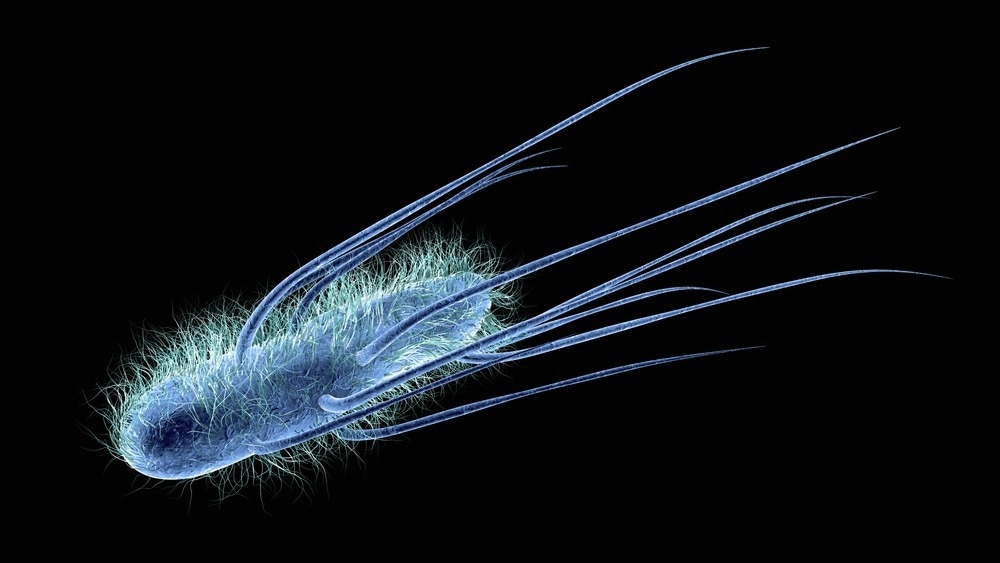Reviewed by Danielle Ellis, B.Sc.Sep 20 2023
A research team led by Professor Emeritus Michio Homma and Professor Seiji Kojima from the Graduate School of Science at Nagoya University, in partnership with Osaka University and Nagahama Institute of Bio-Science and Technology, has gained fresh insights into the mechanism of bacterial locomotion.

Image Credit: Kateryna Kon/Shutterstock.com
The group has pinpointed the significance of the FliG molecule within the flagellar layer, which serves as the bacterial “motor,” uncovering its role in these microorganisms. These discoveries hold potential implications for future engineers working on the development of nanomachines with precise control over their movements. The study detailing these findings has been published in iScience.
As the development of nanomachines progresses towards smaller scales, researchers are turning to microscopic organisms for inspiration on how to enable these tiny machines to move and function.
Among these sources of inspiration is the flagellar motor, which possesses the remarkable ability to rotate both clockwise and counterclockwise at an astonishing speed of 20,000 rpm. When scaled up, this would be akin to a Formula One engine, boasting nearly 100% energy conversion efficiency and the capability to instantly change its rotation direction at high speeds.
If engineers can make a tiny device like a flagellar motor, it could greatly improve how tiny machines move and work, creating new opportunities for what they can do.
In bacteria, the flagellar motor has two main parts: a rotor and a stator. Think of the stator as the engine of a car. The stator's rotation is passed on to the rotor, making it spin, much like how gears work in a car.
In bacteria, the way they move forward or backward is a bit like an automatic car with both drive and reverse settings. This motion is controlled by a protein complex called the C ring.
Inside this C ring, there is a molecule called FliG, which acts like a clutch in a car. It is responsible for switching between forward and backward movement. Just like in a car, all the parts need to work together smoothly. Even the tiniest changes can affect how the motor operates. In the flagellar motor, these small changes are called mutations.
Professor Homma's research team focused on examining a mutant called G215A within the FliG molecule. This particular mutation results in a continuous clockwise rotation of the motor. They conducted tests using the marine organism Vibrio alginolyticus, and their findings revealed that the clockwise motion was attributed to alterations in the FliG molecule and the way water molecules interacted with the protein.
Interestingly, similar changes in FliG and water molecule interactions were observed in the non-mutated form when it rotated clockwise. However, these changes were distinct from those observed when it rotated in the opposite, counterclockwise direction.
The flagellar motor rotates in both directions: clockwise to move backward and counterclockwise to move forward. In this study, we found that the structure of FliG and the interaction of water molecules around it are different when the motor moves clockwise and counterclockwise. This difference allows bacteria to instantly switch between forward and backward movements in response to environmental changes.”
Michio Homma, Professor Emeritus, Graduate School of Science, Nagoya University
Homma concludes, “The clarification of the physical properties of the FliG protein in motors is a significant breakthrough in our understanding of the molecular mechanism that switches the direction of rotation of motors, suggesting ways to create compact motors with higher energy conversion efficiency. Using these findings, it will be possible to design artificial nanomachines that can freely control their rotation, which is expected to be applied to various future fields such as medicine and the design of artificial life.”
Source:
Journal reference:
Nishikino, T., et al. (2023). Changes in the hydrophobic network of the FliGMC domain induce rotational switching of the flagellar motor. IScience. doi.org/10.1016/j.isci.2023.107320.